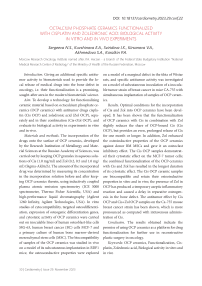Octalcium phosphate ceramics functionalized with cisplatin and zoledronic acid: biological activity in vitro and in vivo experiments
Автор: Sergeeva N.S., Kuvshinova E.A., Sviridova I.K., Kirsanova V.A., Akhmedova S.A., Karalkin P.A.
Журнал: Cardiometry @cardiometry
Рубрика: Conference proceedings
Статья в выпуске: 29, 2023 года.
Бесплатный доступ
Giving an additional specific antitumor activity to biomaterials used to provide the local release of medical drugs into the bone defect in oncology, i.e. their functionalization is a promising, sought-after area in the modern biomaterials’ science
Ocp ceramics, functionalization, cisplatin, zoledronic acid, biological activity in vitro and, in vivo
Короткий адрес: https://sciup.org/148327394
IDR: 148327394 | DOI: 10.18137/cardiometry.2023.29.conf.22
Текст статьи Octalcium phosphate ceramics functionalized with cisplatin and zoledronic acid: biological activity in vitro and in vivo experiments
OCTALCIUM PHOSPHATE CERAMICS FUNCTIONALIZED WITH CISPLATIN AND ZOLEDRONIC ACID: BIOLOGICAL ACTIVITY IN VITRO AND IN VIVO EXPERIMENTS
Moscow Research Oncology Institute named after. P.A. Herzen - a branch of the Federal State Budgetary Institution “National Medical Research Center of Radiology” of the Ministry of Health of the Russian Federation, Moscow
Introduction . Giving an additional specific antitumor activity to biomaterials used to provide the local release of medical drugs into the bone defect in oncology, i.e. their functionalization is a promising, sought-after area in the modern biomaterials’ science.
Aim . To develop a technology for functionalizing ceramic material based on octacalcium phosphate ceramics (OCP ceramics) with antitumor drugs cisplatin (Cis OCP) and zoledronic acid (Zol OCP), separately and in their combination (Cis+Zol OCP), and evaluate its biological activity in experiments in vitro and in vivo.
Materials and methods. The incorporation of the drugs onto the surface of OCP ceramics, developed by the Research Institution of Metallurgy and Material Sciences at the Russian Academy of Sciences, was carried out by keeping OCP granules in aqueous solutions of Cis (1.0 mg/ml) and Zol (0.2, 0.5 and 1.0 mg/ ml) (Sigma-Aldrich). The amount of the incorporated drug was determined by measuring its concentration in the incorporation solution before and after keeping OCP ceramics therein, using inductively coupled plasma atomic emission spectrometry (ICE 3000 spectrometer, Thermo Fisher Scientific, USA) and high-performance liquid chromatography (Agilent 1260 Infinity, Agilent Technologies, USA). In vitro studies of cytocompatibility, targeted osteodifferenti-ation, expression of osteogenic differentiation genes, and cytostatic activity of OCP ceramics were carried out on inoculable lines of human osteoblast-like cells MG-63, human breast cancer (BC) cells MCF-7 and a primary culture of human bone marrow-derived mesenchymal stem cells (MSC). The biocompatibility of samples of the OCP ceramics was studied in vivo on a model of its subcutaneous implantation in BDF1 mice, the osteoconductive properties were explored on a model of a marginal defect in the tibia of Wistar rats, and specific antitumor activity was investigated on a model of subcutaneous inoculation of a inocula-ble tumor strain of breast cancer in mice CA-755 with simultaneous implantation of samples of OCP ceramics.
Results . Optimal conditions for the incorporation of Cis and Zol into OCP ceramics have been developed. It has been shown that the functionalization of OCP ceramics with Cis in combination with Zol slightly reduces the share of OCP-bound Cis (Cis OCP), but provides an even, prolonged release of Cis for one month or longer. In addition, Zol enhanced the osteoinductive properties of the OCP ceramics against donor BM MSCs and gave it an osteoclast inhibitory effect. The Cis OCP samples demonstrated their cytostatic effect on the MCF-7 tumor cells; the combined functionalization of the OCP-ceramics with Cis and Zol has resulted in the longest duration of its cytostatic effect. The Cis OCP ceramic samples are biocompatible and retain their osteoinductive properties in vitro and in vivo; the presence of Zol in OCP has produced a temporary aseptic inflammatory reaction and caused a delay in reparative osteogenesis in the bone defect. The antitumor effect by Cis OCP and Cis+Zol OCP samples on the Ca-755 mouse breast cancer strain has been shown, which is more pronounced as compared with intravenous administration of Cis.
Conclusion . The results obtained indicate the promise of using OCP ceramics as a platform for drug functionalization for further use in reconstructive plastic surgery in oncology.


